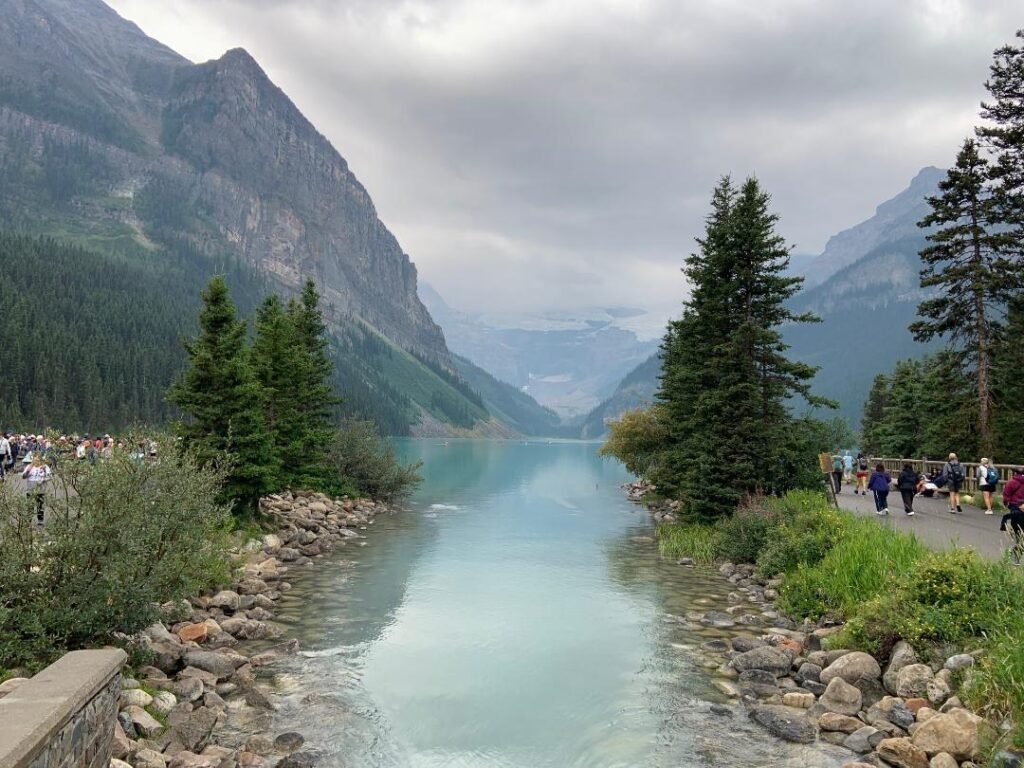Lake Louise is an absolutely beautiful glacial lake within Banff National Park in Alberta, Canada. Banff National Park was Canada’s first national park which was established in 1885.

Lake Louise is located in the beautiful Canadian Rockies with soaring peaks and turquoise water. It is about 35 miles from Banff. The mountain peaks surround the lake and offer visitors stunning views. Those visiting are able to take in these scenic views from the shoreline or from canoes on the lake itself. Lake Louise is the crown jewel within Banff National Park.
Plenty of Scenic Hiking Trails
Hikers will find several trails from the lake front. The Lakeshore Trail runs along the shoreline where you’ll pass glacier waterfalls. You’ll see glacial creeks converge at the far end of the lake. Take a look here on the shoreline and you’ll find every shade of blue imaginable that melds together.
In addition, there are several other scenic hikes in the Lake Louise area. One of these include the Lake Agnes Tea House Hike. This is a 8.9 mile loop trail near Lake Louise which takes about 5 hours to complete. The trail is rated moderate. Another is the Bow River Loop trail. The trail is 4.4 miles long and a round trip takes about 2 hours.
Lake Louise Skiing
Lake Louise is one of the largest ski resorts in North America. As compared to a few other ski areas, Lake Louise offers some great areas for beginners, skiers of moderate ability as well as skiers with advanced ability. Lake Louise Ski Resort consists of 4200 acres of terrain spread across four mountain faces Located just minutes from the town of Lake Louise, this ski resort is known for its terrain from gentle slopes and long cruising runs, to glades, chutes and some of the most exciting, wide open bowls. Just like the Lake Louise area in general, the ski slopes offer incredible views and you may want to bring your camera along. To reach the ski resort you can choose a ski shuttle bus that leaves from town and stops at several hotels.
The Fairmont Chateau
The iconic Fairmont Chateau Lake Louise resort located on the shoreline of Lake Louise is surrounded by absolutely breathtaking scenery. The hotel resort, just like Lake Louise, is located within Banff National Park, a UNESCO World Heritage Site. The Fairmont Chateau Lake Louise operates year round and is a year-round and offers extensive Guided Mountain Heritage programs along with championship skiing in the winter, exceptional food and beverages and a spa.
During the winter months Lake Louise is a frozen scenic wonderland. Find cross country skiers gliding across the lake, ice climbers scaling frozen waterfalls and a horse drawn sleigh following the snow-covered shoreline. Add to this an outdoor skating rink which appeals to visitors of all ages. Also, an ice castle.and a glistening emerald lake. The Fairmont Chateau Lake Louise hotel offers 5-star luxury surrounded by unparalleled natural beauty.
See this related Trips Into History article..
A Visit to Banff Alberta Canada
Lake Louise typically melts from ice near the end of May. Alpine hiking generally begins in June. The peak tourist season at Lake Louise are the months of July and August. These summer months give visitors the choice of hiking, fishing, biking and taking boat tours. With that being said, the winter months are all about snow and ice. You can skate on frozen Lake Louise and immerse yourself in a winter wonderland adventure.
Moon U.S. & Canadian Rocky Mountains Road Trip: Drive the Continental Divide and Explore 9 National Parks (Travel Guide)
Trips Into History searches for various products that we feel the traveling and historic enthusiast community in general can benefit from. As an Amazon Affiliate, Trips Into History earns a commission from qualifying purchases through our links, at no cost to you.
(Article and photos copyright Trips Into History)



